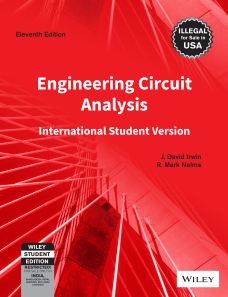Engineering Circuit Analysis, 11ed, ISV
ISBN: 9788126576258
736 pages
Publication Year: 2018
For more information write to us at: acadmktg@wiley.com

Description
Circuit analysis is the fundamental gateway course for computer and electrical engineering majors. Engineering Circuit Analysis has long been regarded as the most dependable textbook. Irwin and Nelms has long been known for providing the best supported learning for students otherwise intimidated by the subject matter. In this new 11th edition, Irwin and Nelms continue to develop the most complete set of pedagogical tools available and thus provide the highest level of support for students entering into this complex subject.
Preface
Chapter 1 Basic Concepts
1.1 System of Units
1.2 Basic Quantities
1.3 Circuit Elements
Chapter 2 Resistive Circuits
2.1 Ohm's Law
2.2 Kirchhoff's Laws
2.3 Single-Loop Circuits
2.4 Single-Node-Pair Circuits
2.5 Series and Parallel Resistor Combinations
2.6 Wye Delta Transformations
2.7 Circuits with Dependent Sources
2.8 Design Example
Chapter 3 Nodal and Loop Analysis Techniques
3.1 Nodal Analysis
3.2 Loop Analysis
Chapter 4 Operational Amplifiers
4.1 Introduction
4.2 Op-Amp Models
4.3 Fundamental Op-Amp Circuits
Chapter 5 Additional Analysis Techniques
5.1 Introduction
5.2 Superposition
5.3 Thévenin's and Norton's Theorems
5.4 Maximum Power Transfer
5.5 Design Example
Chapter 6 Capacitance and Inductance
6.1 Capacitors
6.2 Inductors
6.3 Capacitor and Inductor Combinations
6.4 Design Example
Chapter 7 First- and Second-Order Transient Circuits
7.1 Introduction
7.2 First-Order Circuits
7.3 Second-Order Circuits
7.4 Design Example
Chapter 8 AC Steady-State Analysis
8.1 Sinusoids
8.2 Sinusoidal and Complex Forcing Functions
8.3 Phasors
8.4 Phasor Relationships for Circuit Elements
8.5 Impedance and Admittance
8.6 Phasor Diagrams
8.7 Basic Analysis Using Kirchhoff's Laws
8.8 Analysis Techniques
Chapter 9 Steady-State Power Analysis
9.1 Instantaneous Power
9.2 Average Power
9.3 Maximum Average Power Transfer
9.4 Effective or rms Values
9.5 The Power Factor
9.6 Complex Power
9.7 Power Factor Correction
9.8 Single-Phase Three-Wire Circuits
9.9 Safety Considerations
9.10 Design Example
Chapter 10 Magnetically Coupled Networks
10.1 Mutual Inductance
10.2 Energy Analysis
10.3 The Ideal Transformer
10.4 Safety Considerations
Chapter 11 Polyphase Circuits
11.1 Three-Phase Circuits
11.2 Three-Phase Connections
11.3 Source/Load Connections
11.4 Power Relationships
11.5 Power Factor Correction
Chapter 12 Variable Frequency Network Performance
12.1 Variable Frequency-Response Analysis
12.2 Sinusoidal Frequency Analysis
12.3 Resonant Circuits
12.4 Scaling
12.5 Filter Networks
Chapter 13 The Laplace Transform
13.1 Definition
13.2 Two Important Singularity Functions
13.3 Transform Pairs
13.4 Properties of the Transform
13.5 Performing the Inverse Transform
13.6 Convolution Integral
13.7 Initial-Value and Final-Value Theorems
13.8 Solving Differential Equations with Laplace Transforms
Chapter 14 Application of the Laplace Transform to Circuit Analysis
14.1 Laplace Circuit Solutions
14.2 Circuit Element Models
14.3 Analysis Techniques
14.4 Transfer Function
14.5 Steady-State Response
Chapter 15 Fourier Analysis Techniques
15.1 Fourier Series
15.2 Fourier Transform
Chapter 16 Two-Port Networks
16.1 Admittance Parameters
16.2 Impedance Parameters
16.3 Hybrid Parameters
16.4 Transmission Parameters
16.5 Parameter Conversions
16.6 Interconnection of Two-Ports
Chapter 17 Diodes
17.1 Introduction
17.2 Modeling Techniques
17.3 Analysis Using the Diode Equation
17.4 Diode Rectifiers
17.5 Zener Diodes
Appendix
Complex Numbers
Index

